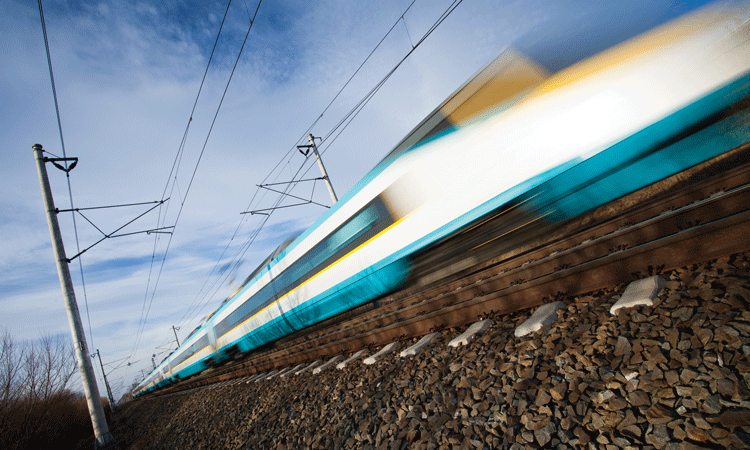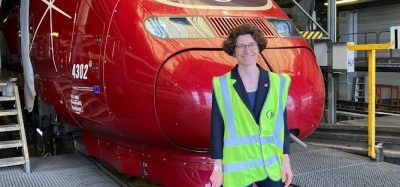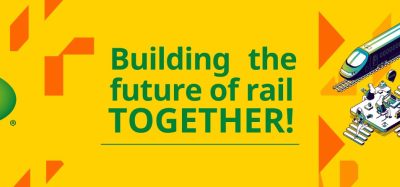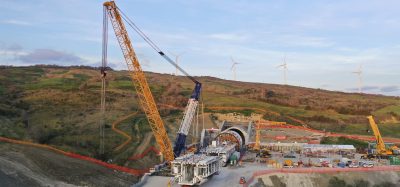High-speed rail’s potential to support transport demand in Europe
Posted: 19 September 2014 | Libor Lochman, Pauline Bastidon | No comments yet
The next decades will be crucial for Europe, with, on the one hand, a desperate need for greater economic growth, and on the other, scarce public financial resources, a growing uncertainty regarding energy supplies, and pressing environmental challenges. High-speed rail has the potential to help address most of these challenges, while supporting the foreseen boom in transport demand1 and underpinning economic growth in Europe. Libor Lochman and Pauline Bastidon from the Community of European Railway and Infrastructure Companies (CER) explore further.


Speed makes rail more attractive
High-speed rail is an essential part of the railways’ modernisation, and presents important advantages compared with other transport modes. The first and biggest advantage of high-speed is to offer much faster train services between cities in Europe, improving connections between major nodes. High-speed trains travelling at 300-320km/h have cut travel time by 45% between Brussels and Frankfurt2 and by more than 60% between Madrid and Barcelona3. Speed makes rail more attractive as a transport mode and helps bring passengers to the trains. This is visible when looking at existing high-speed rail links, such as Paris–Brussels, Paris–Marseille, or Madrid–Seville, where the share of rail transport has increased by a factor 2 to 3 following the introduction of high-speed rail services4.
Rail as the backbone of a sustainable transport system
High-speed rail can and should play a crucial role in the transition towards a sustainable transport system, by potentially replacing short-haul flights and medium-distance car journeys on a wide number of origin-destinations pairs, in particular for international journeys. Experience has shown that when new high-speed lines are built, a large part of the traffic – over 70% – is actually transferred over from air and road. For example, in its 20 years of operations, Eurostar has managed to grasp around 80% of the traffic between Paris and London. In an increasing number of cases, high-speed acts as a feeder for major European airports with long-haul traffic, replacing a large percentage of short-haul flights and allowing major airports to further enlarge their catchment area. This is particularly crucial considering that the number of flights is set to increase by more than 50% between 2012 and 2035, according to EUROCONTROL’s estimates.
The building of dedicated high-speed lines also helps free capacity on the conventional network for both passenger and freight trains. The construction of HS2 in the UK, for instance, is foreseen to lead to a major increase of capacity for freight trains on the major north-south corridors and in particular the West Coast Main Line, with space for around 85 freight trains per day between Wembley and Rugby, versus 58 currently5. Phase 1 of the construction of HS2 is also likely to more than double commuter seat capacity on congested lines, according to recent estimates from the UK Government6.
Economic and environmental benefits of high-speed
In addition new traffic is induced which would not have occurred without the creation of a high-speed link, demonstrating that the building of high-speed lines does not only result in modal shift from air and road to rail, but also attract additional passengers. A 2009 analysis on passengers travelling on new high-speed rail links showed that 33% of demand was generated by the new rail service7 itself, thanks to improved interregional connections. This is essential for the economic development of regions and cities linked to the high-speed network. In this respect, estimates for the building of the HS2 line in the UK have shown that HS2 will help drive regional regeneration and invigorate regional economies north of London, and help create around 100,000 new jobs8 – 70% of which will be located outside of London – and generate an annual productivity boost of up to £15 billion for the UK economy9.
The economic benefit for society is visible when comparing the average level of external costs generated by various transport modes. The International Union of Railways (UIC) assessed the average level of external costs generated by different modes of transport for a journey of 1,000 passenger-kilometres10. The lowest level of external costs was generated by high-speed rail, followed by coach (twice as much), flights (more than twice as much) and cars (more than three times the costs generated by high-speed rail per passenger-kilometre). Moreover, contrary to common belief, high-speed rail is by far the most energy-efficient mode of transport for passengers. The UIC evaluated that while high-speed rail can carry 170 passenger-kilometres per unit of energy (1kWh), buses can only carry 54 passenger-kilometres and flights only 20 per unit of energy.
Finally, in terms of land use, a double-track for high-speed rail using a 25m-wide band of land allows operators to transport 16,000 passengers per hour, while it takes two triple lanes of motorway using three times as much land for the transportation of 15,300 passengers by car.
The EU’s ambitious targets
The potential of high-speed rail was recognised in the 2011 EU Transport White Paper, which sets ambitious targets for high-speed rail. To meet these targets, the high-speed rail network should triple in size by 2030, with a completion of the European high-speed network by 2050, most medium-distance passenger transport should travel by rail by 2050, and all airports on the European core network should be connected to the rail network, preferably high-speed, by 2050.
Realising the EU vision for high-speed: conditions of success
To fully seize the benefits of high-speed rail and attract more passengers to rail, the rail sector will of course need to do its bit and to continue putting passengers at the heart of rail transportation. The emergence of smart ticketing and innovative apps providing tailored and real-time information will help rail operators provide door-to-door solutions, taking up opportunities offered by e-business. Smart co-modality – such as air-rail partnerships – will also increase the attractiveness of rail, as demonstrated by current examples of such collaborations.
However, while the rail sector must play its part to seize the potentials of high-speed, the primary responsibility lies with decision-makers – in particular concerning the infrastructure needed to operate high-speed services. Conventional lines, even with major upgrades, are unable to operate at more than 200-220km/h, and new lines therefore need to be built to reach higher speeds. The average cost in Europe for the construction of 1km of new high-speed line lies between €12-30 million, while the maintenance of 1km of new high-speed line is estimated to be €70,000 per year11. High-speed rail infrastructure must be designed, inspected and maintained in optimum conditions for safety reasons. All this comes at a substantial cost; the decision to invest in such a system therefore requires high political will, a cooperative approach between infrastructure and operations, and a thorough study of market potential, traffic forecasting, costs and benefits of new high-speed projects. According to several studies, 9-15 million passengers per annum are needed for high-speed rail to be worthwhile economically12.
Given the cost associated with it, investment in high-speed infrastructure should not come at the expense of the development and maintenance of the conventional railway network, which is of utmost importance for local and regional passenger traffic and for the transportation of goods and materials by rail.
The new TEN-T proposal and European co-funding coming from the Connecting Europe Facility (CEF) instrument are there to facilitate the building of new high-speed lines and connections. However, national funding remains crucial. In this respect, prospects are fairly negative for high-speed in Central and Eastern Europe, where political decisions have shifted funding away from rail infrastructure towards road infrastructure over the last decade. Although total infrastructure investment has risen in EU12 since 2002, most of the funding has gone to the road network, and actual investments in the rail network have decreased sharply.
Crucially, the conditions for high-speed train operators need to be set appropriately. Infrastructure charging for high-speed is usually distance-based which puts it at a disadvantage compared to air transport, where infrastructure charging is airport-linked. Although the access charges levied on train operators vary substantially, they usually absorb between 25% and 45% of the revenue of high-speed rail operators13. As a consequence, high-speed rail loses its competitiveness against air transport with journey times above three hours.
General framework conditions such as infrastructure charges will therefore have an impact on the future of the high-speed rail network and on the competitiveness of high-speed rail versus other modes. High-speed rail will only be able to thrive if final prices for customers are competitive compared with other modes. Hence full internalisation of the external costs of transport, and a greater harmonisation of infrastructure charges are essential pre-requisites.
High-speed rail might, and should, become the ‘transport mode of the future’, but this will only be the case if funds are available for investment in the infrastructure, if appropriate framework conditions are in place, and if all stakeholders – national authorities and governments, infrastructure managers and railway undertakings – work hand-in-hand.
References
- The 2011 EU Transport White Paper foresees a growth of more than 50% of passenger demand in p.tkm by 2050
- European Commission estimate
- UIC study on ‘High Speed Rail: fast track to sustainable mobility’, 2012
- TRT Trasporti e Territorio SRL, ‘Potential of modal shift to rail transport: Study on the projected effects on GHG emissions and transport volumes’, 2011
- 2012 Report produced by Network Rail and Passenger Focus, ‘Future priorities for the West Coast Main Line: released capacity from a potential high speed line’; http://www.networkrailmediacentre.co.uk/imagelibrary/downloadmedia.ashx?mediadetailsid=5339&sizeid=-1
- UK Department for Transport, 2013, guidance document: ‘High Speed 2: an engine for growth.’
- TRT Trasporti e Territorio SRL, ‘Potential of modal shift to rail transport: Study on the projected effects on GHG emissions and transport volumes’, 2011
- UK Department for Transport, 2013, guidance document: ‘High Speed 2: an engine for growth’; https://www.gov.uk/government/publications/high-speed-two-an-engine-for-growth/high-speed-two-an-engine-for-growth. These estimates capture only the effects of HS2 immediately around the stations and in the design and construction of the network
- Estimate from ‘High Speed 2: the regional economic impact’ – a 2013 KPMG study commissioned by the UK Department for Transport; http://www.kpmg.com/UK/en/IssuesAndInsights/ArticlesPublications/Documents/PDF/Market%20Sector/Building%20and%20Construction/hs2-regional-economic-impact-1.pdf
- UIC study on ‘High Speed Rail contribution to Environment and Sustainable mobility’; uic.org/highspeed
- UIC brochure ‘High speed rail: Fast track to sustainable mobility’
- Chris Nash, Institute for Transport Studies, University of Leeds: ‘High Speed Rail Investment: an overview of the literature’
- UIC study: ‘Infrastructure charges for high performance passenger services in Europe’, 2008











